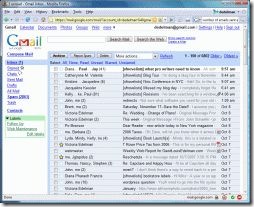Mozilla Firefox managed to become the web browser of choice among techies and a legitimate mainstream alternative to Microsoft Internet Explorer in just a few years. So why is the Mozilla Foundation’s Thunderbird e-mail client dying a slow, painful death?
 Recently, Mozilla began talking about spinning off or abandoning Thunderbird altogether. And just the other day, Scott McGregor and David Bienvenu, the two principle developers of Thunderbird, left the project. (Or at least it appears that way; they’re no longer working for the Foundation, but they’re staying on as volunteer “module owners,” whatever that means.) Mozilla has also brought on David Ascher of ActiveState to launch “a new mail and communications software initiative.” What exactly does that mean? Well, it’s not clear. Apparently Mozilla is skimping on paying their PR people too. (Update 10/9/07: See Al Billings’ comment below for some links to Mozilla’s explanations for what’s going on there.)
Recently, Mozilla began talking about spinning off or abandoning Thunderbird altogether. And just the other day, Scott McGregor and David Bienvenu, the two principle developers of Thunderbird, left the project. (Or at least it appears that way; they’re no longer working for the Foundation, but they’re staying on as volunteer “module owners,” whatever that means.) Mozilla has also brought on David Ascher of ActiveState to launch “a new mail and communications software initiative.” What exactly does that mean? Well, it’s not clear. Apparently Mozilla is skimping on paying their PR people too. (Update 10/9/07: See Al Billings’ comment below for some links to Mozilla’s explanations for what’s going on there.)
I’ve tried to use Mozilla Thunderbird before. Every time I configure a new computer, I try to go Thunderbird. The prospect of a vibrant, evolving e-mail client with a zillion plugins is just too good to ignore. But here’s the problem: it just doesn’t fuckin’ work. Every time I try to use Thunderbird for extended periods of time, it crashes on me. Repeatedly. Ungracefully. Perhaps they’ve changed things since version 1.5, but Thunderbird doesn’t recover nicely from crashes the way Firefox does. You lose messages. It’s irritating as hell.
Don’t take my word for it; I’m not the only one who’s had problems with Thunderbird. The commenters on Slashdot aren’t exactly technoidiots — most of them, anyway — but in the Slashdot discussion “Thunderbird in Crisis?” I’ve learned that Thunderbird also:
- Permanently loses all your e-mail if a folder climbs over 2GB in size
- Has an import function that’s “more buggy than a New York City apartment in the summer”
- Only shows three e-mail accounts in your accounts folder, regardless of how many you actually have
- Doesn’t have its shit together where calendar integration is concerned
Thunderbird’s not the only e-mail client that’s in transition. The once-mighty Eudora software has been discontinued by Qualcomm, and Microsoft has changed its bare-bones e-mail client from Outlook Express to Windows Mail to Windows Live Mail in the space of a year. Yahoo’s webmail has been undergoing a facelift for the past, oh, thirty years, and so far everyone except Walt Mossberg has greeted it with an overwhelming yawn.
You want to know why programmers lose their hair? Ladies and gentlemen, I give you the state of electronic mail!
It’s been approximately 35 years since Ray Tomlinson tacked together two names and an “@” symbol to create the e-mail address. The latest estimates say that there are about 171 billion e-mail messages sent per day (of which 70% are spam). And yet just look at all the things you still can’t do reliably across platforms on e-mail:
- Confirm that your e-mail has been received
- Indicate high or low importance on a message
- Ensure that your message will reach its recipient
- Authenticate that the message sender is who she says she is
- Include basic formatting like bolding, italicizing, and underlining
- Have a reasonable expectation that your message won’t be intercepted by someone else
E-mail standards are still all over the place. When Mac users send mail to Outlook users, often the formatting is stripped out or filled with unintelligible characters. When Outlook users send e-mails to any other client, there’re still burdened with clunky, semi-invisible attachments. Some e-mail clients prevent you from opening attachments; others block CSS styling. Some, like Gmail, strip out just about everything but the plain text.
Hell, you can’t even count on e-mail software being able to display URLs correctly. Half the time, your long URLs end up getting sliced in half when they reach the 72- or 80-character line limit — itself an idiotic relic that should be moldering away in the Incan burial chamber of technology by now. This same limit is responsible for the incomprehensible way most e-mail programs thread long conversations. Certainly you’ve noticed that once you’ve got an e-mail thread longer than three or four messages, the whole thing devolves into an unreadable mess of “>” symbols and line breaks.
 Not only have we not advanced in the field of e-mail at all; we’ve moved backwards. Your e-mail is actually less likely to reach its intended recipient than it was ten years ago, because of overly aggressive spam filters.
Not only have we not advanced in the field of e-mail at all; we’ve moved backwards. Your e-mail is actually less likely to reach its intended recipient than it was ten years ago, because of overly aggressive spam filters.
As usual, Google’s on the case, and as far as I can tell, they’re the only major player pushing innovation right now. I’ve got a love/hate relationship with Gmail, their flagship mail product (see my previous blog post “Why Is Gmail So Irritating?”), but at least they’re thinking outside the envelope. Once they integrate Gmail with their Google Gears offline API, they’ll have a rather formidable e-mail offering.
Here is Doctor Edelman’s prescription for how to fix e-mail: Don’t. Let it die, and start from scratch.
I’d like to see a bunch of major software vendors get together — Google, Microsoft, Yahoo, AOL, IBM, Apple, etc. — and come up with a new electronic messaging system. I don’t care if it’s open source, but the party should at least be open to independent developers. Make every user pay a nominal fee to an international standards body to register for it, and then charge a very small fee per message (say, a penny) to discourage bulk e-mailing. Have multiple methods of validation behind CAPTCHAs so that at least we’ll slow the spammers down. Only allow a restricted subset of attachments to be sent across it — no executables allowed — and do a virus scan of everything at the source.
Is it possible to eliminate spam on this new e-mail system? Maybe it’s not possible to completely eliminate it. Yet somehow I’ve never received a spam message on my Facebook account, and every friend invitation I’ve received has come from a real, live human being. Certainly if Facebook has figured out a way to reliably authenticate the identities of tens of millions of users, it’s not an impossible task.
I’m not saying anyone has to kill good ol’ SMTP e-mail. After all, Usenet’s still around, isn’t it? We can all maintain our goofy anonymous Hotmail addresses for sending out party invitations and arranging illicit sexual liaisons. But we should have a real e-mail system where the grown-ups can safely and reliably communicate too.
And while we’re fantasizing about the impossible: why not throw a few more things into the mix?
One thing that Google seems to have recognized before anyone else is that communication is communication, no matter how you format it or what protocol it gets transmitted on. We have too many needless choices for our digital communications today. Why should I have to choose whether I want to use STMP, IM, RSS, HTML, SMS, MMS, VoIP, fax, or voice to send my wife a two-sentence message? I should be able to just click an icon on my desktop, type in my message, and click Send. Let our digital overlords determine the best route to convey the message to its recipient; I honestly don’t care. I don’t want to be bothered thinking about communication protocols any more than I feel like running IP traceroutes to determine the shortest number of hops between our machines.
So an ideal communication client would seamlessly handle every major format listed above in one interface. It would treat e-mails and IMs and blog comments and faxes the same. It would archive all your communications in a single database, so you wouldn’t have to check five different app logs to find it later.
This is essentially getting back to the vision that Tim Berners-Lee had for the World Wide Web in the first place: an easy-to-use method of universal communication. No more FTPing files down from an IP address you’ve scribbled on a piece of notebook paper. Just point at the hyperlink and click; all the work of translating the hyperlink to a specific file on a specific web server is completely transparent to the user.
There’s no reason we should have to muck around with multiple communication interfaces anymore. After all, what’s a web page except an e-mail to the world, cc everybody?